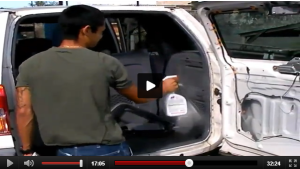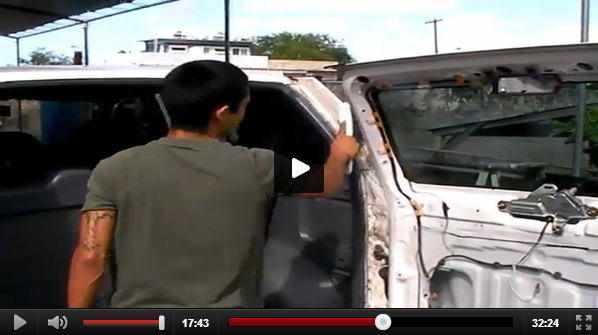Discover Why Using an Auto Surface Cleaner during Auto Paint Prep Ensures Optimum Adhesion of any Auto Undercoat and Top Coat.
Wax and Grease Remover
Before any vehicle surface is fit for the application of an auto undercoat or top coat such as primer and paint, it has to be as clean as possible through the use of auto surface cleaners such as wax remover and grease remover (wax and grease remover) and also but of slightly less importance, auto glass cleaner.
Why do I need to use Wax and Grease Remover?
Absolutely all traces of dirt, grease, oil, silicone and any other surface contaminants must be removed. It is a simple known fact that any auto undercoat and top coat will not stick to dirt, wax or grease.
When do I need to use Wax and Grease Remover?
Prior to sanding, after sanding, prior to the application of body filler, between undercoats and top coats and after a thorough and meticulous wash, the use of an auto surface cleaner such as wax and grease remover used on your vehicle is of huge importance.
Always bare in mind that each paint system will have its own recommended auto surface cleaners.
How do I apply Wax and Grease Remover?
The best cleaning results are obtained by using one cloth dampened with wax and grease remover to initially wipe surfaces using one hand, followed by a clean dry cloth in the other hand to remove lingering residue and moisture.
Be absolutely certain that the cloths you use are clean and completely free from all traces of wax, polish, oil or anything else.
IMPORTANT: Every part of any surface to be painted must be cleaned with a wax and grease remover product prior to the application of paint.
If you don’t use such a type of auto surface cleaner, you run the risk of contaminants on the surface ruining an otherwise professionally applied paint job.

What safety precautions do I need to take?
Be sure to follow label instructions when using auto surface cleaners, including the use of rubber gloves and any recommended protective respiratory device.
For your convenience, you may wish to pour wax & grease remover into a spray bottle that is clearly labeled; being a clear liquid with few identifying characteristics it would be easy to confuse this product with some other product found in your work area.
- Auto Glass Cleaner
Some auto painters supplement their wax and grease remover cleaning with an additional wipe down using an auto glass cleaner. This will ensure super clean and dry surfaces are achieved.
Ammonia in auto glass cleaner helps to disperse and evaporate moisture, as well as to pick up missed spots of wax or dirt residue. Instead of wetting a cloth with auto glass cleaner, you would spray the material on surfaces and wipe it off with a clean, dry, lint free cloth.
- Tack Cloth
Take the time to wipe the body surface with a tack cloth just before the actual painting begins.
Tack cloths are made from a material that allows it to pick up and retain very fine particles of lint, dust, and other debris.
Although wax and grease removers work well to get rid of contaminants like wax and grease, tack cloths work best for removing tiny pieces of cloth fiber and other items that could easily cause imperfections in paint finishes.
Go over every square inch of body surfaces that will be exposed to paint materials to be certain that all traces of lint are removed. This should guarantee that debris is not blown over onto painted surfaces during the paint process.
Who should use tack cloths?
A tack cloth is very important if you don’t have ideal surroundings for your paint job to take place in. Remember to only rub the tack cloth gently against the surface you are going to paint.
Tack cloths are available to buy at any auto paint supply store. Their cost is minimal, especially when compared to the kind of intricate dust and lint removal they provide.
Open and unfold tack cloths and then lightly fold them back again. This will loosen them up to make them more manageable.
Tack cloths have a limited life span so be sure to take note of any package instructions or user recommendations to ensure adequate and complete cleaning is achieved at all times.
I hope you enjoyed the blog today. Talk to you soon! Bye!
-Tony
P.S. If you want to learn more, about auto body and get all the information you need so you can customize your projects, learn how to restore your classic or put a body kit on your car, check out VIP here: LearnAutoBodyAndPaint VIP Course.
Other Helpful Links:
Painting Auto Body Panels And Blending Paint
Automotive Paint Prep Part Removal Tips
Learn Auto Body and Paint Q&A – Auto Bodywork Tips and Answers

Thanks Tony very informative!!!!
Glad you like it bud.
will it remover ceramic coating from paint?
No, you may need to just sand it off.
Thanks for sharing this with me
Awesome, Charles! Hey check out VIP and see how it can help you with your own car projects! https://learnautobodyandpaint.com/free-autobody-manual
Very informative and just what I needed to here I’ve painted my door and I’m about to rub down the top coat with 2000 grit wet n dry before applying clear coat and just wanted to know when to use degreasant and when to use tack cloth, many thanks
Best of luck Derek! Have you checked out VIP? https://www.learnautobodyandpaint.com/vip-offer/